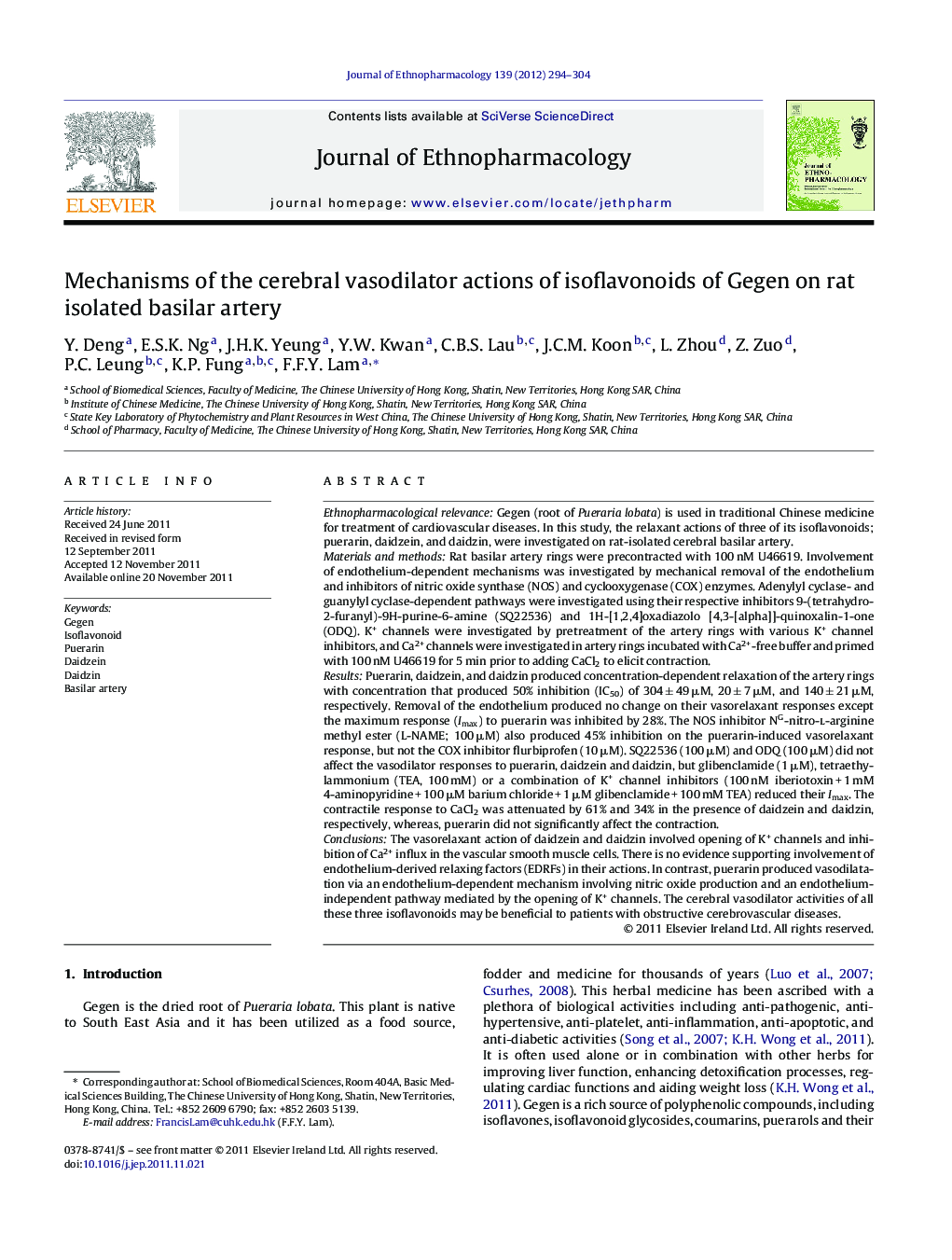| کد مقاله | کد نشریه | سال انتشار | مقاله انگلیسی | نسخه تمام متن |
|---|---|---|---|---|
| 5839151 | 1123987 | 2012 | 11 صفحه PDF | دانلود رایگان |

Ethnopharmacological relevanceGegen (root of Pueraria lobata) is used in traditional Chinese medicine for treatment of cardiovascular diseases. In this study, the relaxant actions of three of its isoflavonoids; puerarin, daidzein, and daidzin, were investigated on rat-isolated cerebral basilar artery.Materials and methodsRat basilar artery rings were precontracted with 100 nM U46619. Involvement of endothelium-dependent mechanisms was investigated by mechanical removal of the endothelium and inhibitors of nitric oxide synthase (NOS) and cyclooxygenase (COX) enzymes. Adenylyl cyclase- and guanylyl cyclase-dependent pathways were investigated using their respective inhibitors 9-(tetrahydro-2-furanyl)-9H-purine-6-amine (SQ22536) and 1H-[1,2,4]oxadiazolo [4,3-[alpha]]-quinoxalin-1-one (ODQ). K+ channels were investigated by pretreatment of the artery rings with various K+ channel inhibitors, and Ca2+ channels were investigated in artery rings incubated with Ca2+-free buffer and primed with 100 nM U46619 for 5 min prior to adding CaCl2 to elicit contraction.ResultsPuerarin, daidzein, and daidzin produced concentration-dependent relaxation of the artery rings with concentration that produced 50% inhibition (IC50) of 304 ± 49 μM, 20 ± 7 μM, and 140 ± 21 μM, respectively. Removal of the endothelium produced no change on their vasorelaxant responses except the maximum response (Imax) to puerarin was inhibited by 28%. The NOS inhibitor NG-nitro-l-arginine methyl ester (L-NAME; 100 μM) also produced 45% inhibition on the puerarin-induced vasorelaxant response, but not the COX inhibitor flurbiprofen (10 μM). SQ22536 (100 μM) and ODQ (100 μM) did not affect the vasodilator responses to puerarin, daidzein and daidzin, but glibenclamide (1 μM), tetraethylammonium (TEA, 100 mM) or a combination of K+ channel inhibitors (100 nM iberiotoxin + 1 mM 4-aminopyridine + 100 μM barium chloride + 1 μM glibenclamide + 100 mM TEA) reduced their Imax. The contractile response to CaCl2 was attenuated by 61% and 34% in the presence of daidzein and daidzin, respectively, whereas, puerarin did not significantly affect the contraction.ConclusionsThe vasorelaxant action of daidzein and daidzin involved opening of K+ channels and inhibition of Ca2+ influx in the vascular smooth muscle cells. There is no evidence supporting involvement of endothelium-derived relaxing factors (EDRFs) in their actions. In contrast, puerarin produced vasodilatation via an endothelium-dependent mechanism involving nitric oxide production and an endothelium-independent pathway mediated by the opening of K+ channels. The cerebral vasodilator activities of all these three isoflavonoids may be beneficial to patients with obstructive cerebrovascular diseases.
286
Journal: Journal of Ethnopharmacology - Volume 139, Issue 1, 6 January 2012, Pages 294-304